Understanding how much water arborvitae need is crucial for maintaining their health and beauty.
Arborvitae, a coniferous tree with five distinct species, is often chosen for ornamental purposes because of its iconic cone or pyramidal shape and ease of maintenance.
While they are known for resilience, determining how much water arborvitae need is essential to their care.
This article will provide insights into the precise water amounts Arborvitae requires throughout its growth stages.
The general guideline is ensuring that the soil around the Arborvitae remains consistently moist.
This could mean running a hose at the base for a few hours weekly for mature trees. However, the specific water volume varies depending on climate, tree age, and planting time.
By knowing how much water arborvitae need, you'll ensure their health is optimal. Paired with proper soil drainage, adequate watering is paramount for Arborvitae's well-being.
Continue reading to explore ideal watering practices for both young and mature Arborvitae and how to recognize when they might need more hydration.
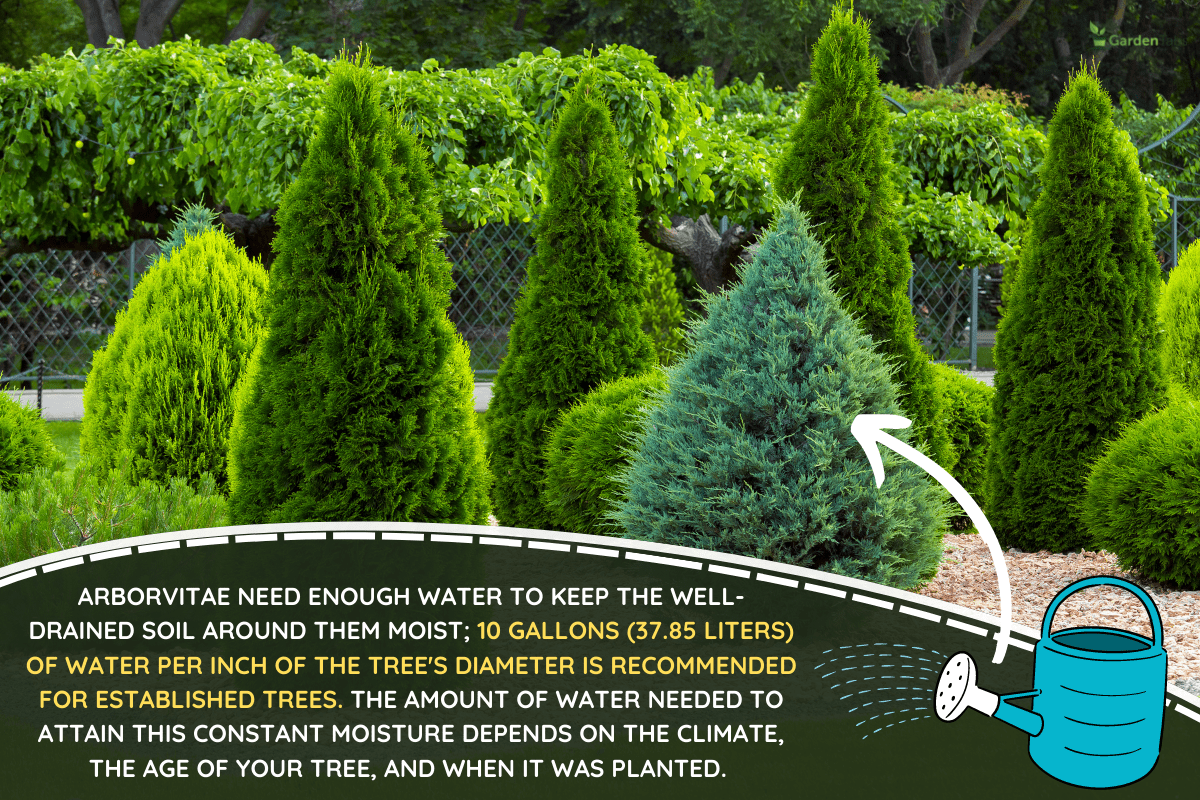
How Much Water Does Arborvitae Need?
When watering your Arborvitae, consider how to keep the moisture in the soil for the most extended periods.
The dried-out ground can lead to dried-out roots, leaving your tree in bad shape.
Watering in a low and slow style is very beneficial for this type of tree. Add small amounts of water over time to achieve consistently moist soil.
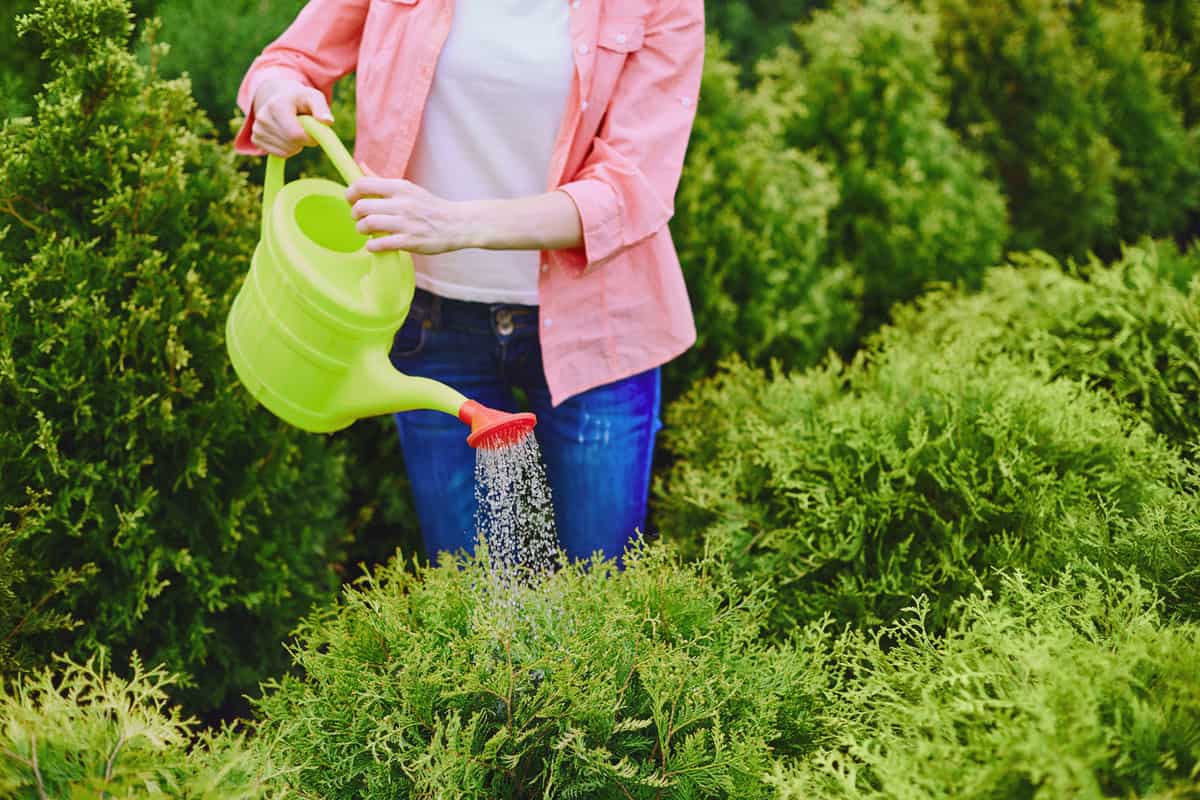
To keep up with the climate, you will have to add more water in dry periods and water a little less in wet or cold seasons.
Moderated water is a critical point in the care of Arborvitae.
Proper water management will give you beautiful, green Arborvitae all year round. Drying out or drowning both bring up problems for this tree.
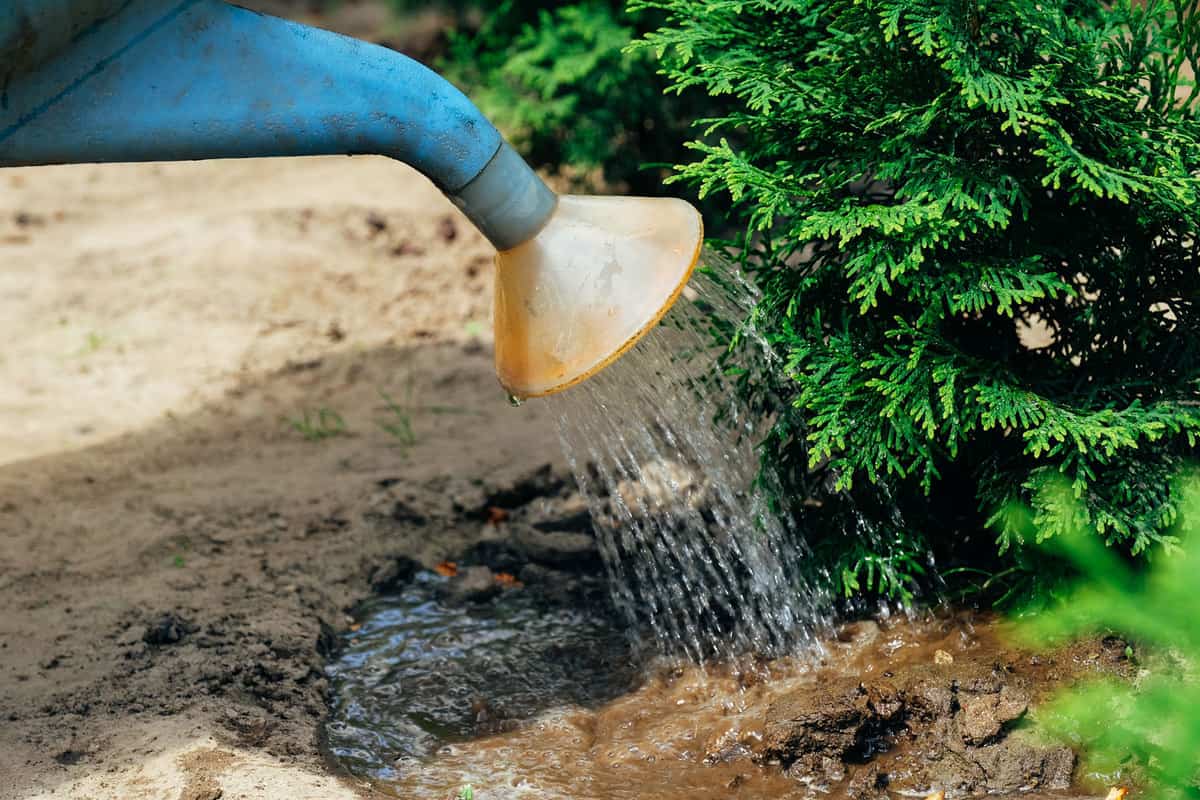
Are you worried that your tree is getting too much or insufficient water? It's a valid thing to worry about.
Some guidelines for watering are unique to the age of your tree or when it was planted. Let's discuss these guidelines in more detail.
The video below shows a quick guide on how to water your Arborvitae:
Read more on our blog post, “Arborvitae Tree Going Brown And Dying — What To Do?”
How Often Should You Water Newly Planted Arborvitae?
Newly planted Arborvitae require thorough watering to help settle soil around the roots and remove air pockets.
A weekly soaking is recommended during the first year after transplant, especially if planted in a dry climate. In a wet environment, nature may take over this responsibility.
The slow drip of water is ideal for newly planted trees. A drip can be created by allowing a garden hose to drop a few drops of water per minute over hours.
Right after planting, allowing a water drip for 2-4 hours daily is ideal.
After two weeks of daily watering, you can reduce the drip to 2 hours every other day. The longer your tree is in the ground, the less water it will require.
Read more on our blog post, “How Fast Do Arborvitae Grow?”
How Often Should You Water Established Arborvitae?
Established Arborvitae should have firm roots that need not be watered daily.
These adult trees can even survive periods of drought, although it is ideal for keeping consistently moist soil at all stages of life.
Using the drip method, you can decrease watering to 2 hours of dripping once a week after your tree is in the ground for 6 weeks.
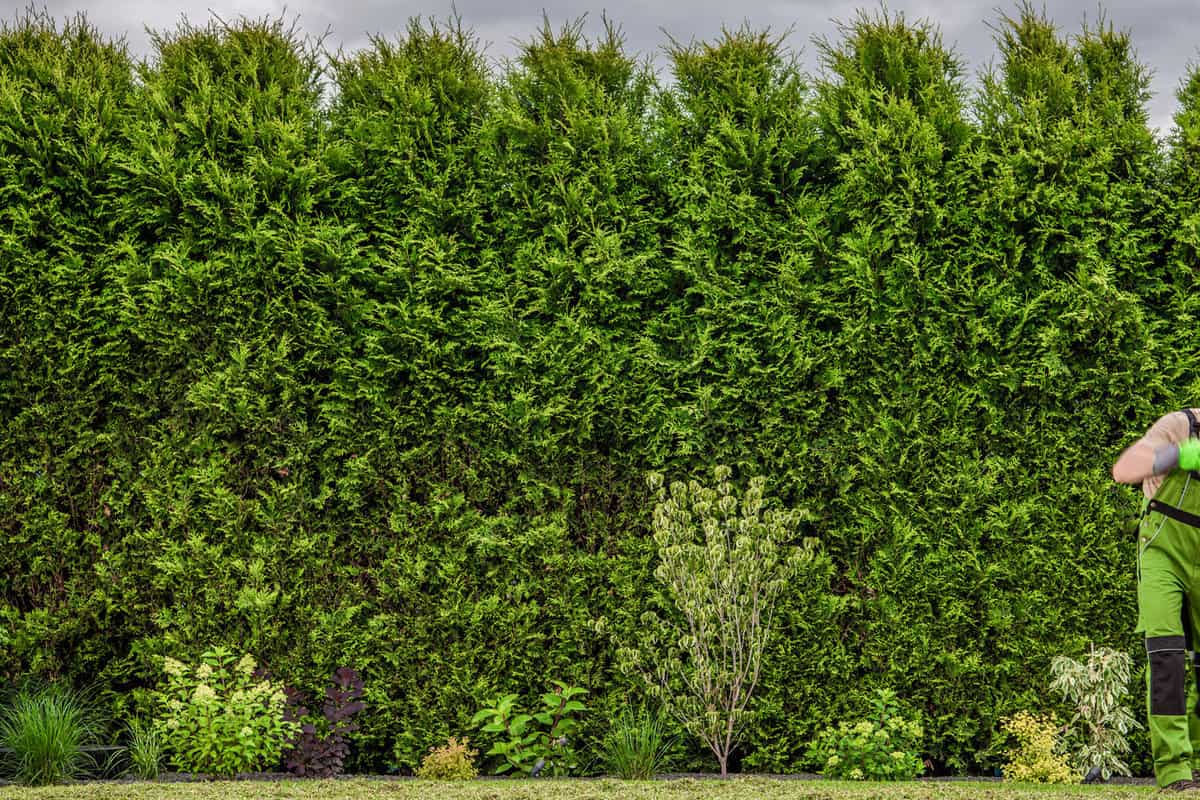
If you live in an arid climate or are experiencing a long period of drought, then you will have to provide more water.
Checking the foliage of your trees often for signs of dehydration is a good idea to catch watering early. Let's discuss what these signs look like.
How Do I Know If My Arborvitae Needs Water?
If you peek at your trees daily, it will be easy to know when something changes. It is good to see the difference between normal signs of aging and signs of underwatering or dehydration.
It is usual for interior branches of Arborvitae to turn color and fall off in Autumn.
Do not confuse this process with drought stress. Flagging or drought stress will appear on the outside branches of this tree.
You will see this exterior foliage turning yellow or brown. Other signs of under-watering include needle drop and loss of vigor.
If you notice signs of dehydration, remove or prune affected branches.
After an in-depth prune, you can keep consistently moist soil through drip irrigation and consider fertilizing at this point.
The video below showcases how to troubleshoot a symptomatic Arborvitae tree:
Read more on our blog post, “Should You Fertilize Arborvitae?”
How Do I Know If My Arborvitae Is Overwatered?
Symptoms of overwatering your Arborvitae can be similar to those of underwatering.
You may see this change to yellow or brown colors in the branches and needle drop.
Too much moisture or insufficient drainage can also lead to root rot. In this condition, your Arborvitae is susceptible to infections or fungal infestations.
When the soil around your tree is compacted or planted in a low spot, the risk of overwatering due to rain increases.
Alongside discoloration and dieback, you may also see edema or wet and wilting leaves in an overwatered Arborvitae.
If you have an overwatered Arborvitae, let the soil dry before watering again.
If fungi or other pests overran your tree in this period, you must treat these conditions to get your tree back into a healthy state.
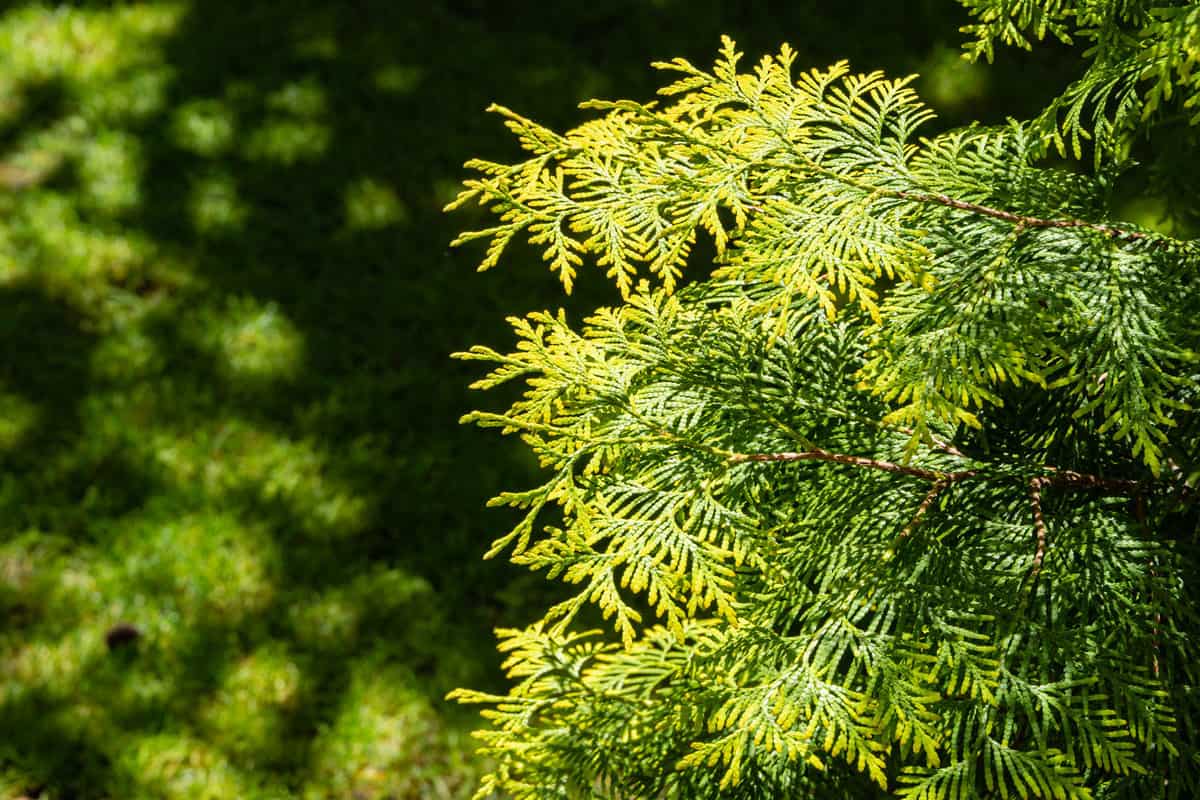
Maybe you can't get the soil to dry out due to rain or site placement.
At this point, you will need to aerate the soil or add a drainage system to keep up with the water coming in. Properly drained soil is critical for the health of these trees.
Read more on our blog post, “How Long Do Arborvitae Live? [By Type]”
Is It Better To Water Trees In The Morning Or Evening?
The watering time affects how much of your water supply makes it to your tree.
Watering your plants early morning or night reduces the amount of water lost through evaporation.
So, which is better, morning or evening?
Early morning is the best time to water your Arborvitae. These are the hours before temperatures rise and winds are less intense.
Providing water in the early morning creates a reservoir that your tree can draw from when temperatures and sunlight increase later in the day.
![Small arborvitae trees planted for a proposed hedge, How Much Water Do Arborvitae Need? [With Regards To Its Life Stage]](https://gardentabs.com/wp-content/uploads/2021/08/Small-arborvitae-trees-planted-for-a-proposed-hedge.jpg)
What if you missed early morning or your schedule doesn't allow time for watering then?
The next best thing is to water in the evening, at least 2 hours before dusk. This will give your leaves ample time to dry off.
Watering too close to the dark can increase the chances of your tree being too wet for too long.
This leaves your Arborvitae susceptible to root rot, fungal infections, or other pests.
Learn more on our blog post, “How To Get The Best Vertical Garden Watering System.”
Transplant Shock in Arborvitae: What to Do
Transplant shock happens when arborvitae trees are uprooted and replanted, leading to stress, wilting, or yellowing.
Preventing Transplant Shock:
It's always easier to prevent a problem than fix it later, right? Here's how to minimize the risk of transplant shock in your arborvitae:
Timing is Everything: Plant your arborvitae in early spring or fall when the weather is milder.
Mind the Roots: Handle the root ball gently during planting and avoid damaging the roots.
Water Wisely: Water your arborvitae thoroughly immediately after planting and keep the soil consistently moist during the first few weeks.
How to Address Transplant Shock
If you think your arborvitae is suffering from transplant shock, don't worry! Here's what you can do:
Keep Up the Water: Ensure your arborvitae have consistent moisture access. Please give it a deep soak every few days, especially during hot or windy weather.
Mulch It Up: Mulching around the base of your arborvitae can help retain moisture and keep the soil temperature stable.
Hold Off on Fertilizing: Feeding a struggling plant is tempting, but waiting until your arborvitae has fully recovered from transplant shock before adding fertilizer is best.
Be Patient: Recovery can take time. It might be a growing season before your arborvitae fully return from transplant shock. Keep up the care, and give it time!
Arborvitae Diseases and How to Prevent Them
Root Rot: The number one villain that comes for your arborvitae is root rot. It sneaks up when the soil is too wet and doesn't drain properly.
Let's nip this in the bud, shall we? Make sure you've got well-draining ground and keep your watering in check. Not too much, not too little, just right.
Fungal Infections: Nobody likes a fungus among us, especially your arborvitae. Wet leaves are a fungus's best friend, so do your trees a favor and water at the base, not the leaves.
If you've had a lot of rain, skip a watering or two. Your arborvitae will thank you.
Pest Infestations: Bugs, bugs, go away, don't come again another day! Pests like aphids and spider mites can be a real headache.
Keep an eye out for these little critters, and if you spot them, consider introducing some natural predators like ladybugs. They'll do the dirty work for you.
Dealing with Winter Burn in Arborvitae
Winter burn happens when your arborvitae loses more water through its leaves than it can absorb from the frozen ground.
This dehydration leads to browning or "burning" of the foliage. You may notice this happening more often on your arborvitae's sunnier, windier side.
How to Prevent Winter Burn
You know what they say - prevention is better than cure! Here are some tips to keep winter burn at bay:
Proper Planting: Plant your arborvitae in a spot shielded from harsh winter winds and afternoon sun.
Keep them Hydrated: Before the first frost, give your arborvitae a deep watering to ensure they go into winter with plenty of moisture.
Mulching: Add a mulch layer around your arborvitae's base to retain moisture and regulate soil temperature.
Consider a Windbreak: If you're in a particularly windy area, consider setting up a burlap windbreak to protect your trees.
What to Do If You Spot Winter Burn
Winter burn can look worse than it is. Once the ground thaws in the spring, give your arborvitae an excellent soak to help them recover.
Prune away any severely damaged branches and be patient - your trees may bounce back as the weather warms up.
Concluding Thoughts: How Much Water Do Arborvitae Need?
Your Arborvitae, once established, needs an excellent weekly soak.
How you provide this water is done best through a slow drip or a weekly soak, and the water needs change depending on the age of your tree and the climate in which you live.
Your newly planted trees need more attention, and irrigation is provided daily. Your established or older Arborvitae needs less attention but should be checked regularly for signs of over or underwatering.
We hope you found this article helpful in caring for your arborvitae. Happy planting!
Looking for further information on Arborvitae? Look at our blog post, “Do Arborvitae Have Invasive Roots?”

Is that 10 gal. of water per day/week/month?
@Derek, Very Good Question! Throughout the article it appears that she is referring to watering on a weekly basis. I found this information online, but they do not indicate the tree size, so I guess you need to know how old your tree is for this list to help.
Average weekly water requirements in gallons per tree;
Mar, Apr, May June July & Aug Sept – Nov
2 yr old trees_________14_________28_________54_________54
3 yr old trees_________28_________54_________112________112
4-7+ years_____________56_________56_________224________224
@Derek, the previous post removed all spacing, the chart should have read as noted below:
—————Mar, Apr, May—- June—-July & Aug—-Sept – Nov
2 yr old trees_________14_________28_________54_________54
3 yr old trees_________28_________54_________112________112
4-7+ years_____________56_________56_________224________224